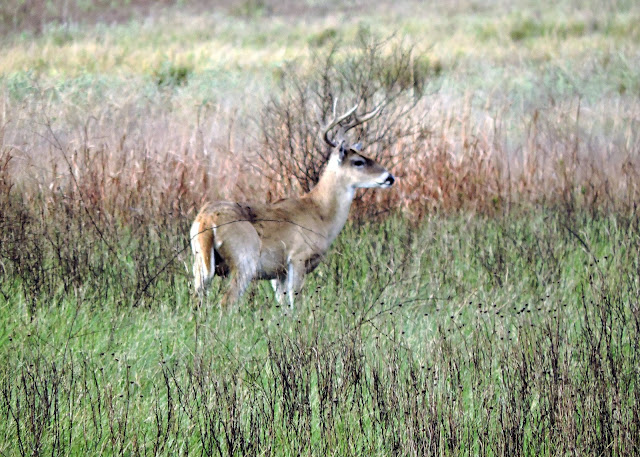We also saw several animals besides birds while in the ANWR. Most abundant were feral hogs and alligators. There were three alligators sunning on the bank across Jones Lake, one quite large, but they were too distant for a cell phone photo, so the photo below is from a birding trip to Padre Island.(Oops! Correction: The photo below was taken at ANWR but is from the Internet. I was too lazy to hunt through my blog photos to find the feral hog photo that Deb took on our birding trip to Padre.)
 |
| Hog rooted up edge to Jones lake. |
 |
| Mike Brady's photo of a fine male white-tail with nice antlers |

Two of my favorite sightings were of dolphins and a glass lizard. Dolphins swam in the Skimmer’s wake and were seen occasionally on our boat observations; and we found a glass lizard on the trail. Once, while out with Jeff in the Sam Houston State University boat, a curious dolphin checked us out, getting close and raising its eye out of the water so that it could see what the heck was going on because Jeff was rubbing his fingers along the side of the boat underwater making squealing/squeaking noises.
 |
| The dolphin that came in to check us out when Jeff made squeaking noises on the side of the boat; Photo Mike Brady |
Glass lizards are interesting. They are legless lizards that resemble snakes . . . until one catches their blunt noses and cute smiles. They differ from snakes also because they have movable eyelids, external ear openings, and inflexible jaws. They are called glass lizards because they can shed their tails (which are more than half the lizard’s length) to foil predators. The tail can shatter into pieces that break off like glass. Each piece squirms and wiggles to attract the predator while the lizard stays motionless and eventually gets away. The glass lizard we found crossing the trail had already used this defensive technique as it was short and had no tapering tail. The new tail grows back slowly over a period of months to years I’ve learned.
When we first moved to Oklahoma, I found a glass lizard when mowing the lawn. I knew immediately that it was not a snake. This one, too, had already lost its tail, so when I picked it up, it had nothing more to lose. Looking back, I am glad. If, when I picked it up its tail had broken off and squirmed around in the grass, I would have squirmed around, too.
When we first moved to Oklahoma, I found a glass lizard when mowing the lawn. I knew immediately that it was not a snake. This one, too, had already lost its tail, so when I picked it up, it had nothing more to lose. Looking back, I am glad. If, when I picked it up its tail had broken off and squirmed around in the grass, I would have squirmed around, too.
Mike and Lindsay made one of the most talked about sightings. It was a fleeting look at best, but the two determined that what they had seen crossing the road behind Jeff’s truck was a cat. I thought Lindsay said that the animal was about the size of a chocolate lab (I kidded her about the chocolate part) but Mike says that it was about the color of a chocolate lab. Anyway, their best guess was that it was a Gulf Coast jaguarundi, a cat native to Mexico, that is a little smaller than a housecat, and with a small head and long body and tail. It is said to resemble more an otter than a cat. If they did see a jaguarundi, this is wonderful news! The last confirmed sighting of this subspecies in the U.S. was 30 years ago in April of 1986.
 |
Note the long body and small head of the jaguarundi in these Internet pix. These animals can be chocolate lab colored also.
|




No comments:
Post a Comment